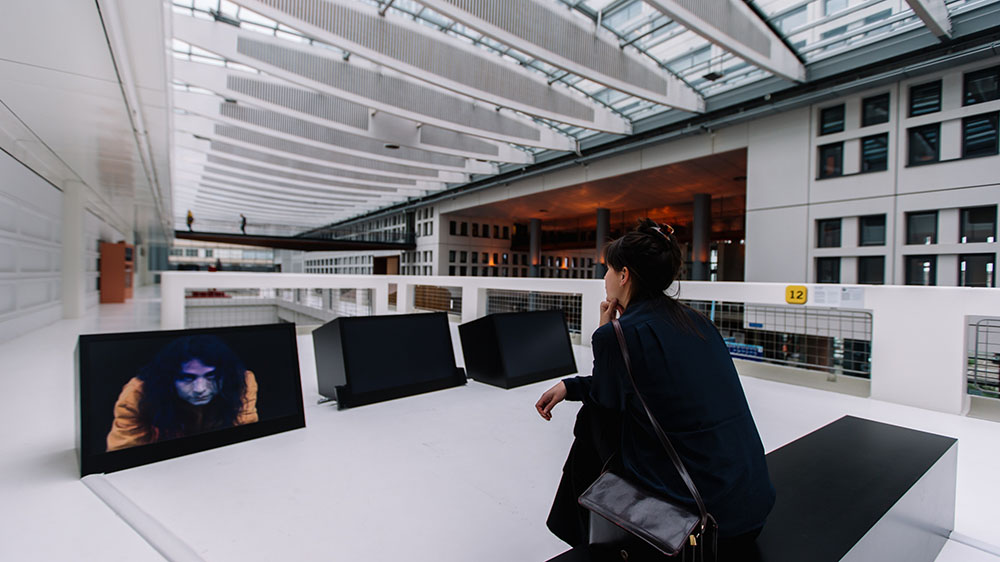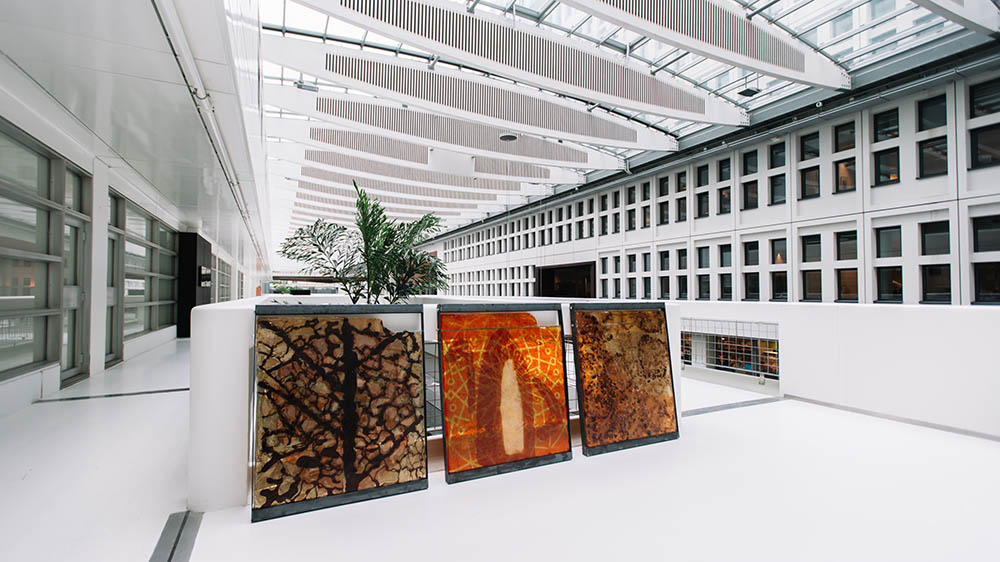Science Gallery Rotterdam is a new public space at
Erasmus MC, where science, design, art, society and
education meet.
an interview with Fred Balvert 
In the essay accompanying the first exhibition of Science Gallery Rotterdam curator William Myers says both art and science have the power to initiate paradigm shifts. “(UN)REAL”, which is the title and theme of the exhibition, workshops and related events bring together scientific researchers, students, local communities and artists in surprising and innovative ways to discuss and inspire each other for the future and may point to a paradigm shift.
We talked to Fred Balvert, director of Science Gallery Rotterdam about the concept and the exhibition showing 15 artworks of artists from all over the world including 6 from Rotterdam.
What is Science Gallery? Science, Art, Design, Technology, Collaborations?
Erasmus MC is a research centre and a university medical centre. Most people think it
is a hospital but there is much more going on there especially in research and education. We believe it is important not only to present the outcome of research to the public but also to involve them in the process. We had already the idea of a presentation room when we found out about the Science Gallery concept. It is an initiative started 10 years ago in Dublin. Currently, there are 8 science galleries in the world including us. A Science Gallery is always initiated by a university. What is unique in Rotterdam is that Erasmus MC is the only Science Gallery specialized in biomedical research. Science Gallery Venice, for example, is completely different. It focuses on different topics such as economics, which leads to very different artworks, of course.
The idea is that we don’t present the research when already finished, but rather we create a dialogue around it beforehand by involving artists, designers - who are just as
much imaginative thinkers as scientists - and of course the public. It is a very nice and creative process. Basically, we organize workshops with artists and researchers for
young people between 15-25 from Rotterdam and involve them in making of an exhibition. We have realized it would have been a very different exhibition if we had made it entirely from the science perspective. I think art has a place in our society where people can freely ask questions and frame research topics in radically different ways.
We plan for one exhibition per year. Because of the renovation of our permanent space, the exhibitions will be at different locations in the Erasmus MC and maybe outside of the building complex as pop-ups for three years. I have to say we learned a lot from the challenges of setting up this first exhibition such as the building regulations we had to meet. When we have our own space we will have more freedom.
Broom Groom - Marit Shalem (Photo: Lisa Eileen)
What is the benefit of being part of an international network?
First of all, it gives us the format: dialogue through workshops challenges young
people to think deeply and differently and the exhibition as a result of the dialogue. Secondly, the infrastructure: it provides us with the possibility of reaching out to an international audience from all over the world. Our open call can easily reach artists and researchers as well as the exhibition can receive more publicity by being on the
Science Gallery International website. I can imagine when we have our own space we could also work with other structures. There are other compelling exhibition concepts related to science and art that could be interesting to adapt. I recommend artists to follow the Science Gallery International website, there are around 8-9 open calls per year. There is already an art community around Science Gallery. Some of the artists are into biomedical research; others are from different background but feel attracted to it.
Are you planning to collaborate with other Science Galleries?
Yes, we have already talked about co-producing an exhibition with Dublin. I have
also seen science galleries taking over another Science Gallery’s exhibition. This could be also something that we do, move a complete exhibition here or at least some of the
works developed by another Science Gallery.
How did you choose the title “(UN)REAL”?
We organized a workshop with young people from Rotterdam age 15 – 25 years old
and discussed their view on science and research. We found out the main subject they were interested in was the idea of real/ unreal and the barrier between them. We
discussed about fake identities, fake news, and physical qualities of the body as well as the future possibilities of having babies. Advances in genetic engendering brought
up social and ethical questions and we were talking about whether genetic engineering is changing our reality in a way we can understand. From all the
discussions we had during the workshops we summed up a central theme, which became the title of the exhibition.
In Posse: Female Sperm - Charlotte Jarvis (Photo: Lisa Eileen)
Is there an artwork especially you would like to talk about?
Charlotte Jarvis’ work beautifully deals with the theme of real/unreal. She is
attempting to engineer female semen completely from female cells as part of a
collaboration with research scientist Prof. Susana Chuva de Sousa Lopes at the Leiden University Medical Center. Charlotte’s work brings up the question if we could
change the reality in a way we like. On the one hand, her work is very technical; on the other hand, it has social and artistic layers. She deals with the cultural meaning of male dominance and questions how we look at female and male qualities in our culture. Charlotte also refers in her work to one of the most widespread festivals in ancient Greece, Thesmophoria, where no men allowed. She connects her research with the fact that we know very little about this festival because men were forbidden from seeing or knowing about the rites; the festival was women-only and thus largely undocumented. These many layers of her work made it very nice to discuss it with young people.
It is notable to mention that Prof. Lopes received the prestigious 1.5 million VICI grant to conduct the scientific experiments for this project. It is a great example of an artist idea leads to the most prestigious grant in the Netherlands.
Erasmus MC has a great art collection started in 1966. Also, the university has a gallery on the Kralingen Campus. Is there a connection to Science Gallery?
Not so much. They both are different art collections and the Science Gallery is a completely new project separated from them. We had to discuss with Erasmus MC beforehand to make sure we are on the same page. Erasmus MC is collecting art with the idea of making the building more beautiful for visitors, students, patience and employees. Science Gallery aims to create dialogue around the research and address provocative questions.
We are not only promoting research but rather we address social-ethical questions around it. We were happy to realize that researchers also appreciate the dialogue around their work. In the same time, it is a good opportunity for the public to express their expectations, hopes, fears and worries about biomedical research.
What will happen to the artworks after the exhibition?
The artworks remain the property of the artist. As part of the Science Gallery concept, all artworks also will become part of the Science Gallery International archive and other Science Galleries can use the artwork for other exhibitions. Sometimes a whole exhibition can travel from one gallery to another. In this exhibition, the works are not permanent, many of them are installations and some of them are built into temporarily frames to meet the building regulations. In this case, only the concept will go to the archive the rest will be dismounted. Some photos could be the part of the collection, I guess.
Sugar: A Cosmology of Whiteness - Nadine Botha (Photo: Lisa Eileen)
Are exhibitions and workshops open to the public?
Yes, the exhibition is open to the public and can be visited as it is in an open space. As I mentioned it is currently a pop-up exhibition in the passage of Erasmus MC. We
follow the RIVM regulations and made some adjustments in some of the work’s presentation. For example, we used speakers instead of headphones. Only the workshops were restricted to young people and closed from the rest of the public.
Do you have a personal story to share related to the exhibition?
We had a workshop with Joep van Lieshout. I love the way he sees everything as a system, body but also sociaty as a system. His ideas are often very radical. In the beginning, I thought it might be shocking to young people but it was the opposite. They appreciated listening to his stories that were very much based on his insights on how the world works. He had the workshop together with one of our researchers Eric Steegers about perinatal mortality. Eric concerned about the fact that the Netherlands is one of the 20 most prosperous countries in the world yet the perinatal mortality is still high. It is very dramatic that we have this state of the art medical centre in a city, in the same time the perinatal mortality is at the level of less developed countries. I think everyone learned from the discussions. It made me realized we don’t have to be afraid of the fact that art can be provocative or shocking. People are very well capable of putting it to a context. We just need to find a topic that researchers and artists have in common and the rest will go by itself. It is better not to prepare too much and give more chance to young people to respond and ask critical questions.
6 April, 2020
Fred Balvert Director of Science Gallery Rotterdam, science communicator and Head of the Congress Agency of Erasmus MC. He is also a Senior Lecturer in Science Communication Management at Rhein-Waal University of Applied Sciences.
(UN)REAL
03.04.2020 – 01.07.2020 (extended until 29.11.2020)
curated by William Myers
Artists:
Dan Lloyd (USA)
Antye Guenther (Rotterdam) | Ani Liu (USA), Nadine Botha (Rotterdam) | Clara Bolle (Rotterdam) | Gavin Vaughan (UK) | Amy Karle (USA) | Nilou Esfandiary (UK) | Suki Chan(UK) | Marleine van der Werf (Rotterdam) | Marit Shalem (Rotterdam) | Charlotte Jarvis (UK) | Louisa Zahareas and Kimon Kodossis (NL) | Tim Waldekker (Rotterdam) | Atelier Van Lieshout (Rotterdam) | Robert Good (UK) | PentHouss / Anna Lann and Jonathan Trichter (UK/ FR)
Location:
Science Gallery Rotterdam
Erasmus MC
Doctor Molewaterplein 40
3015 GD Rotterdam
Science Gallery Rotterdam is currently a pop-up location in the passage of Erasmus
MC. This can be reached via the main entrance of Erasmus MC or the entrance to the
Museum Park. The Museumpark entrance is temporarily closed due to the corona crisis.
Open:
Erasmus MC opening times
Subscribe to our newsletter
We will not share your name or email with third parties and of course you can unsubscribe at any time.

















